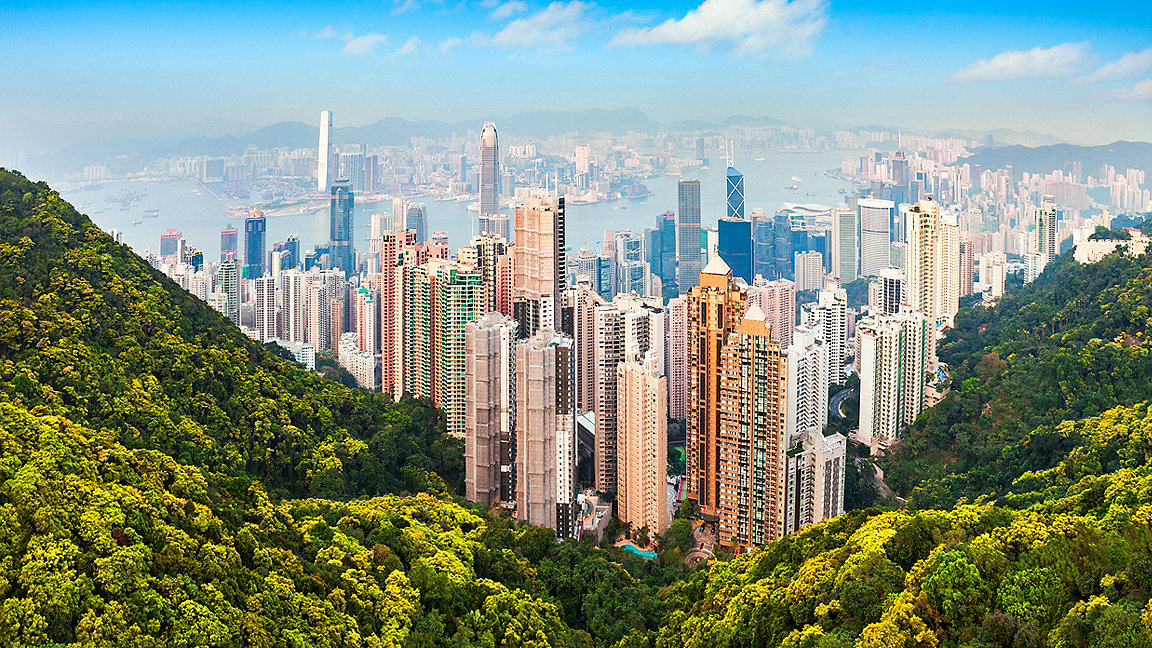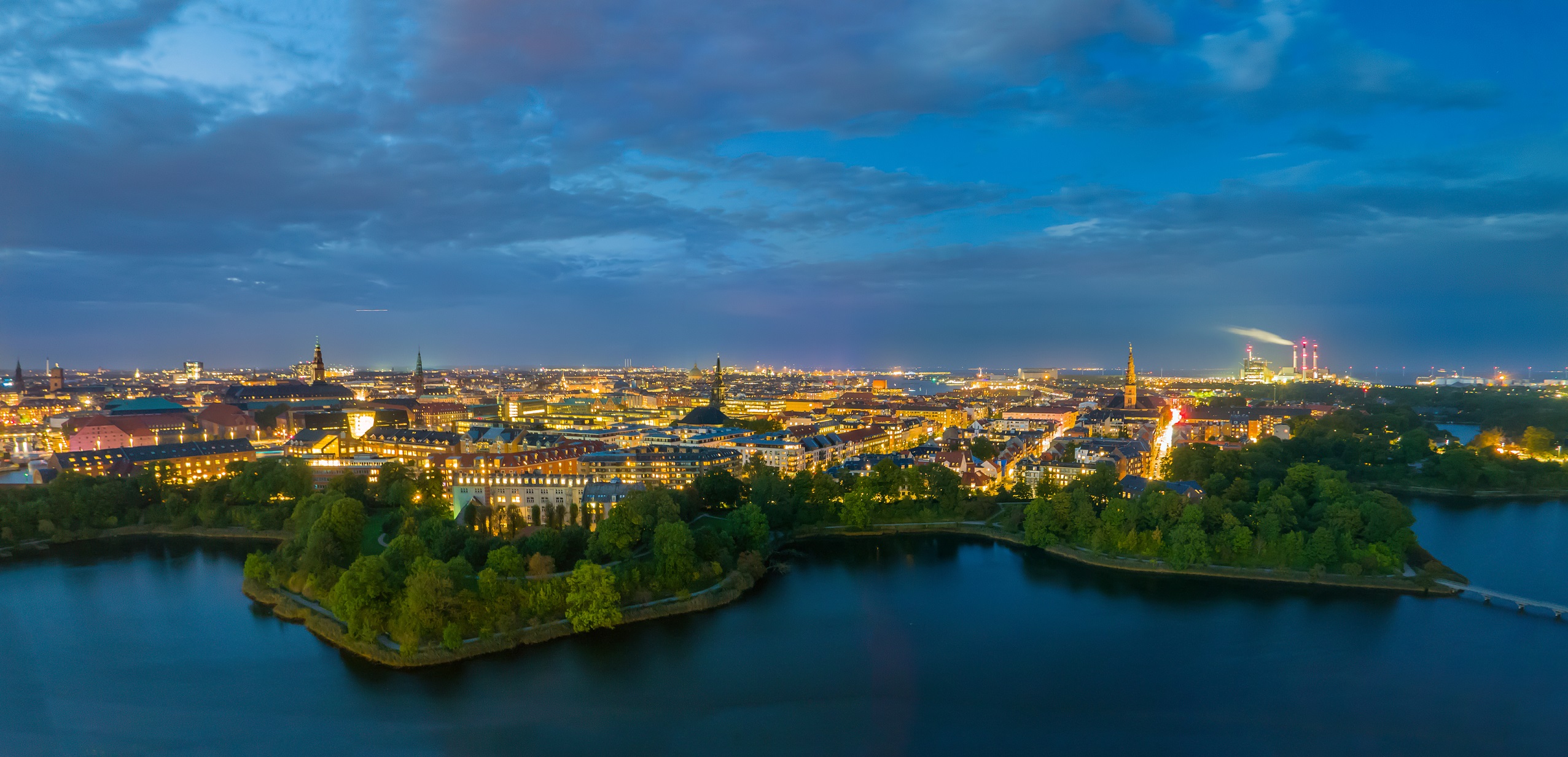
Hong Kong consists of an isolated outcrop of islands and granite mountains draped in thick jungle; more than 75% of its land is unsuitable for development. But over 200 years this rocky outcrop has been transformed against all odds to become one of the world’s most glamorous cities.
Hong Kong presents a visual and metaphorical illusion of its green credentials. Luscious green slopes rise impossibly high out of an emerald green sea, dwarfing a glittering skyline that boasts the highest number of skyscrapers in the world. Clouds cling to the mountain peaks as mists swirl through valleys lost to time. But alongside this natural splendour, the neon signs blaze, the streets buzz, and the noise deafens.
While other cities across the region, such as Singapore and Shanghai, have taken substantial steps to address the need for sustainable urban design, commercial buildings in Hong Kong still contribute to more than 60% of its carbon emissions and 90% of electricity usage. For context, in the USA these figures stand at 38% and 40%, respectively.
As the world's largest emitter of carbon dioxide, The People's Republic of China aims to have 70% of all new buildings meeting government approved sustainability measures by the end of 2022 in a bid to achieve carbon neutrality by 2060. As a Special Administrative Region, Hong Kong aligns with this target, but with one of the highest population densities globally and a severe shortage of land for development this is a daunting challenge
From its humble beginnings, Asia's 'world city' has overcome multiple challenges, but in a post-COVID-19 world with more focus on sustainability and net carbon emissions, how can Hong Kong defeat its improbable geography to tackle this head-on?
Starting the conversation
Much has changed in Hong Kong since the COVID-19 pandemic began. The real estate sector is starting to have genuine conversations about sustainability and ESG (environmental, social and governance) for the first time. There has been an awakening of sorts, led by occupiers but also driven by ESG reporting requirements which means that for most investors, landlords and developers, incorporating 'green features' into their properties is now paramount.
Historically, the real estate sector has limited tackling sustainability to a series of practice notes covering development parameters and green coverage of a site and focus more on general development control than encouraging developers to incorporate innovative solutions.
For the commercial sector, at least, the conversation is being driven to a large extent by ESG reporting and occupier preferences. Occupiers are increasingly factoring sustainability into their office decision making. Even as far back as 2009, a study carried out in the USA analysed the office occupancy patterns of more than 10,000 US corporates and found that more than 40% of the space they occupied could be certified as 'green space'. This number is likely to be significantly higher now. In Hong Kong, a survey last August of more than 550 corporate occupiers found that around 90% agreed that tackling real estate emissions is essential, while about 62% would be willing to pay a premium to lease a 'green certified' building.
While average office rents fell by 4.2% in 2021 overall, I analysed a pool of more 'green' buildings and found that the average rent over the same period increased by 1.4% with an average vacancy rate of 6.0% compared to the citywide average of 10.7%.
From a valuation perspective, this will result in a premium on the capital value of 'greener' buildings, while valuers may also consider applying a degree of compression to the capitalisation rates of such buildings. Actual sales evidence is scarce due to Hong Kong's unique market where local developers tend to build the assets and maintain ownership.
Investor interest
It's not just occupiers either. Investors are increasingly aware of the need for sustainability, with a 2021 survey by EY finding that 98% of investors surveyed assess ESG, while of these 72% will carry out a structured review of ESG performance before deciding whether to invest. To illustrate the changing sentiment, this number stood at just 32% in 2019.
Listed Companies in Hong Kong will need to comply with The Task Force on Climate-Related Financial Disclosures framework by 2025. This will require companies to make climate-related disclosures and sustainability reports to shareholders and the public. The idea is that it will 'promote more informed investment, credit, and insurance underwriting decisions'.
While for many it may be considered a cynical view, real change is often only achieved when real capital losses may be incurred and Hong Kong is no different.
Banks and investors are no longer keen to put their money into developments that might be washed away by rising oceans or decimated by drought. As a result, companies are becoming more active in managing their portfolios against sustainability benchmarks such as the Global Real Estate Sustainability Benchmark (GRESB).
We've seen multiple developers and investors recruit ESG experts to help them comply with these benchmarks and reporting standards. Over the past year, more developers, landlords, and Real Estate Investment Trusts (REITs) have released their ESG strategies and announced their targets. Asia's largest REIT in terms of market cap, Link REIT, aims to be net-zero by 2035, while two of the largest developers, Sino Land and New World Development, have pledged to achieve that by 2050.
Geographical challenge
However, the significant hurdle companies face is Hong Kong's geography. The weather is sweltering for much of the year, and humidity regularly surpasses 80%, so buildings need significant artificial cooling to remain comfortable – it is estimated 70% of all energy consumption in some office buildings in Hong Kong is from air conditioning.
The majority of Hong Kong's most valuable office buildings are built on reclaimed land, clustered just above sea level, to form one of the densest urban areas in the world, resulting in the urban heat island effect exacerbating matters and making them vulnerable to climate change from rising seas and while land reclamation may provide additional land for development, the environmental costs of doing so are enormous, effectively negating any potential carbon offsetting that could be achieved with the development of new buildings.
Innovating to meeting the challenge
Investors and developers in Hong Kong must be increasingly innovative to meet their sustainability targets. Two prominent landlords, Hong Kong Land and Swire Properties, have announced that 86% and 97% of their portfolios respectively are certified green buildings, but what steps are other investors taking to retrofit their facilities, and how are developers incorporating sustainable features into new buildings?
Buildings have traditionally faced Victoria Harbour to maximise views, which exposes them to solar radiation. Now, developers adopt shading features such as canopies, as seen at Manulife Place in Kowloon East.
In many older buildings, the air conditioning is either on or off. But with new technology, property managers in facilities such as ICC in West Kowloon can optimise conditions for each floor based on real-time data and in smart buildings, this process can be automated.
ICC, Hong Kong's tallest building, plans to install photovoltaic cells, covering around 120,000 sq m of its exterior, and wind turbines to produce power. Meanwhile, a special silver-based coating was applied to the glazing, reflecting heat to keep the building cooler.
Innovative design ideas are extending to new developments. In November 2021, the highly prized Site 3 was sold in Central. Alternative cooling measures to reduce its reliance on air conditioning are a hot topic. Some ideas have included dry misting, shading or using plants to create a micro-climate.
On the other side of Victoria Harbour, there are plans to use seawater for a centralised cooling system in the new Kai Tak redevelopment, which is expected to be around 35% more efficient than traditional systems. With most buildings within a few hundred metres of the sea, this could enjoy wider use if successful.
Valuers need to accurately appraise the value of sustainable features. Most clients will broach the subject, and a two-tier market may emerge between green and less green buildings. Indeed, we may see greater redevelopment of older properties as this value gap widens, which would be another step in the right direction as Hong Kong faces another defining period in its long, remarkable history.


